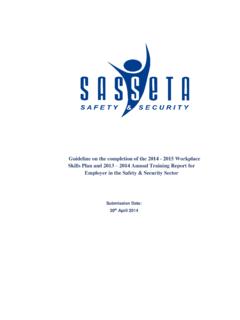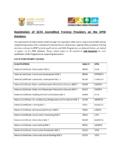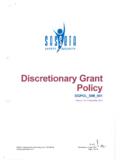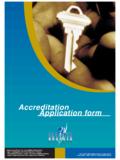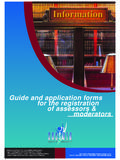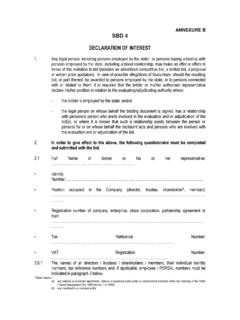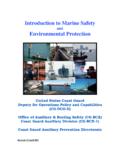Transcription of Safety and Security Sector: An Explanation of the Private ...
1 Safety and Security sector : An Explanation of the Private Security Sub- sector in South Africa ii Monograph Vol 1, No 7 Private Security Sub- sector 2016 Safety and Security sector : An Explanation of the Private Security Sub- sector in South Africa November 2016 SASSETA Research Division Monograph Vol 1 Number 7 ------------------------------------ Land line: 011 087 5500 Call Centre: 011 087 5555 Fax: 086 762 0156 Email: Website: Address: Riverview Office Park, Janadel Avenue Midrand, Republic of South Africa. iii Monograph Vol 1, No 7 Private Security Sub- sector 2016 TABLE OF CONTENTS ABBREVIATIONS AND ACRONYMS .. v EXECUTIVE SUMMARY .. vii 1. INTRODUCTION .. 1 Background .. 1 Methodology .. 1 Limitations .. 1 Outline of the report .. 2 2. PROFILE OF THE SUBSECTOR .. 2 Scope of coverage .. 2 Key role players and their functions.
2 3 The Private Security Industry Regulatory Authority (PSiRA) .. 3 Employer 4 Labour organisations .. 4 Associations and institutions .. 4 Other Security service partners .. 4 Economic performance .. 5 Employer profile .. 6 Number of Private Security businesses .. 6 Categories of Security services .. 7 Provincial distribution of businesses .. 8 Labour market profile .. 8 Employment .. 8 Provincial distribution of employees .. 9 Occupational distribution of employees .. 10 Population group .. 11 Gender .. 11 Age .. 12 3. KEY SKILLS ISSUES .. 13 Change 13 Crime rates and the changing nature of crime .. 13 Professionalisation and compliance of the subsector .. 13 Advances in information technology (IT) and convergence .. 15 Legislation, national plans and strategies .. 16 Security training .. 16 Code of Conduct for Security providers.
3 16 Firearms Control Act .. 17 Private Security Industry Regulation Amendment Bill .. 17 Employment Tax Incentive Act .. 17 Broad-Based Black Economic Empowerment Amendment Act .. 18 Other national plans and strategies .. 18 Implications for skills planning .. 18 4. THE EXTENT OF SKILLS MISMATCHES .. 20 Extent and nature of demand .. 20 Extent and nature of supply .. 21 Supply-side 22 Identification of scarce and critical skills .. 24 Scarce skills .. 24 Critical skills .. 26 5. PARTNERSHIPS .. 26 6. STRATEGIC SKILLS DEVELOPMENT PRIORITIES .. 27 7. CONCLUSIONS .. 28 8. REFERENCES .. 30 iv Monograph Vol 1, No 7 Private Security Sub- sector 2016 LIST OF TABLES Table 2-1 Number of Private Security businesses registered with PSiRA and SASSETA 2011-2014 .. 6 Table 2-2 Number of Private Security businesses operating in the various categories of Security Service, 2014.
4 7 Table 2-3 Occupational distribution of Private Security subsector employees, 2012-2014 .. 11 Table 2-4 Population group of Private Security subsector employees, 2012-2014 .. 11 Table 2-5 Gender of Private Security subsector employees, 2012-2014 .. 12 Table 2-6 Age of Private Security subsector employees, 2012-2014 .. 12 Table 4-1 SAQA qualifications relevant to the training of Security officers .. 22 Table 4-2 Private Security scarce skills (using OFO 2012) .. 25 LIST OF FIGURES Figure 2-1 Provincial distribution of registered Private Security businesses, 2014 .. 8 Figure 2-2 Employment in the Private Security subsector 2012-2014 .. 9 Figure 2-3 Provincial distribution of Private Security subsector employees, 2014 .. 10 Figure 2-4 Provincial distribution of registered and employed Security officers 2014 .. 100 Figure 2-5 Gender of registered and employed Security officers 2013-2014.
5 12 ANNEXURES ANNEXURE A: METHODOLOGY USED IN WEIGHTING OF DATA .. 32 ANNEXURE B: Private Security ASSOCIATIONS AND ORGANISATIONS .. 33 v Monograph Vol 1, No 7 Private Security Sub- sector 2016 ABBREVIATIONS AND ACRONYMS AMCU Association of Mineworkers and Construction AWU Abonqobi Workers Union B-BBEE Broad-Based Black Economic Empowerment CCTV Closed-Circuit Television COSAPS Congress of South African Private Security CPD Continuous Professional Development DHET Department of Higher Education and Training DUSWO Democratic Union of Security Workers ESIA Electronic Security Industry Alliance FCSWU Food, Cleaning and Security Workers Union GDP Gross Domestic Product GSO General Security Officer HOTELLICA Hotel, Commercial Catering and Allied Workers Union of South Africa ICT Information and Communication Technology ID Identity IP Internet Protocol IT Information Technology KAWU Kungwini Amalgamated Workers Union NASUWU National Security and Unqualified Workers Union NASWU National Security Workers Union NDP National Development Plan 2030 NKP National Key Point NQF National Qualifications Framework NSDS III National Skills Development Strategy III OFO Organising Framework for Occupations OHS Occupational Health and Safety PAYE Pay As You Earn PSiRA Private Security Industry Regulatory Authority PSSPF Private Security sector Provident Fund PTAWU Professional Transport and Allied Workers Union QCTO Quality Council for Trades and Occupations RPL Recognition of Prior Learning SANSAWF South African National Security and Allied Workers Forum SANSEA South African National Security Employers
6 Association SAPS South African Police Service SAPSWU South African Private Security Workers Union SAQA South African Qualifications Authority SASA Security Association of South Africa SASSETA Safety and Security sector Education and Training Authority SATAWU South African Transport and Allied Workers Union SDL Skills Development Levy SETA sector Education and Training Authority SIA Security Industry Alliance SIC Standard Industrial Classification SOCRAWU Security Officers Civil Rights and Allied Workers Union SSEO Security Services Employers Organisation vi Monograph Vol 1, No 7 Private Security Sub- sector 2016 SSP sector Skills Plan UIF Unemployment Insurance Fund SOCRAWU Security Officers Civil Rights and Allied Workers Union VAT Value-Added Tax WSP Workplace Skills Plan vii Monograph Vol 1, No 7 Private Security Sub- sector 2016 EXECUTIVE SUMMARY Security has traditionally been provided by states to citizens, however, state Security provision has largely been inadequate, focusing mainly on state preservation against external aggression and internal disorder using mainly the military and police, respectively.
7 As a consequence of general lack of Security , a majority of citizens in many developing countries have resorted to self-help in Security provision by utilising the Private non-state sector to address their Security needs. This report was conducted to make inputs to sector skills planning processes. The report is based on desk-top research, an analysis of the workplace skills plans submitted by organisations in the subsector to the SASSETA and other data sources, as well as inputs provided by repre-sentatives of the subsector in individual interviews or in a workshop held by the SASSETA in Au-gust 2015. The report starts with a profile of the Private Security subsector. The subsector includes all busi-nesses and individuals involved in the guarding or protecting of fixed property, premises, goods, persons or employees, including monitoring and responding to alarms at premises that are guarded by persons or by electronic means, and spans a wide range of Security service business categories.
8 The subsector s major customers tend to fall into the following groups: owners of large spaces (such as belonging to government, airports and universities); public Private spaces such as shopping malls; retail and commercial business; corporate; banks; and individual home-owners. Businesses, as well as individuals involved in the provision of Private Security services are re-quired by law to be registered with the Private Security Industry Regulatory Authority (PSiRA). PSiRA is thus a major role player in the subsector, together with other role players such as em-ployer organisations, labour organisations, industry-focused associations and institutions, and other Security service providers such as the South African Police Service (SAPS) and community policing forums. The Private Security subsector is said to be one of the largest employers in the country and is one of the fastest growing local industries.
9 The number of active registered Security officers grew on average by per year from 2011 to a figure of 487 058 in 2014. Industry representatives estimate that the South African Private Security industry is currently worth between R50 and R55 billion. Factors supporting the growth of the subsector over the past decade include the high rates of domestic crime and the desire of businesses and individuals to protect their assets; the increasing prominence of public Private spaces such as shopping malls and the changing nature of crime to target these spaces; and increasing pressure from insurance companies for clients to procure the services of Private Security companies. In future, a plateau in subsector growth may however arise due to weakened demand from key customers: government intends to bring its Security services in-house, and there has been a steady contraction of the mining sector and lo-cal port activities.
10 The numbers of Private Security organisations registered with SASSETA was only 991 in 2014. In 2014, however, 8 144 Security businesses were registered with PSiRA. These businesses range from large extensions of multinational companies, through to large, medium and very small lo-cally owned companies, and also include individuals such as locksmiths and Security consult-ants. Of the PSiRA-registered Security businesses, most provide guarding or patrolling services, entertainment or venue control, bodyguarding, electronic monitoring; special events control, se-curity training, and rendering of Security services or personnel. According to PSiRA data, more than a third of Security service providers are based in Gauteng. Security officers make up the bulk of workers in the Private Security subsector and by law ex-clude only administrators, clerks and other support staff working in the subsector.
